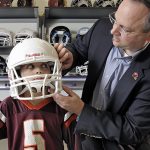A combination of pent-up demand and a growing population of school children put 2012 back-to-school spending in the history books, leaving parents in 2013 with an array of school supplies that still work, and a significantly shorter shopping list. According to NRF’s 2013 Back-to-School Survey conducted by Prosper Insights & Analytics, families with school-age children will spend an average $634.78 on apparel, shoes, supplies and electronics, down from $688.62 last year. Total spending on back-to-school is expected to reach $26.7 billion.
Total back-to-school and back-to-college spending combined will reach $72.5 billion.
“The good news is that consumers are spending, but they are doing so with cost and practicality in mind. Having splurged on their growing children’s needs last year, parents will ask their kids to reuse what they can for the upcoming school season.” said NRF President and CEO Matthew Shay. “As they continue to grapple with the impact of increased payroll taxes, Americans will look to cut corners where they can, but will buy what their kids need. It’s important to note, however, that spending levels are still well above where they were a few years ago.”
The biggest portion of back-to-school shoppers’ budgets will go toward new apparel and accessories: 95.3 percent of those with school-age children will spend an average of $230.85 on fall sweaters, denim and other chic pieces of attire. Additionally, families will spend on shoes ($114.39) and school supplies ($90.49).
Fewer families with children in grades K-12 will purchase electronics (55.7%), and those that are going to invest in a new tablet or smartphone are going to spend slightly less than last year ($199.05 vs. $217.88 in 2012).
Eight in 10 back-to-school shoppers will adjust spending plans because of economy
It’s clear the economy is still weighing heavy on the average family’s mind; the survey this year found eight in 10 school shoppers (80.5%) say economic conditions will change their spending in some way. Turning to the Internet to save money, 36.6 percent say they will do more comparative shopping online and 18.5 percent will shop online more often.
Back-to-school shoppers already out and about
According to the survey, families are already out and about shopping for school items: 23.9 percent of families with children in grades K-12 say they will begin shopping at least two months before school (i.e. right now), up from 22.3 percent last year and the highest percentage seen in the survey’s 11-year history. Half (49%) will shop three weeks to one month before school, 21.8 percent will shop one to two weeks before school, 2.8 percent will shop the week school starts, and 2.6 percent will shop after the start of the season.
“We continue to see a shift in shopping patterns during big spending ‘events’, where consumers typically head out early to take advantage of fresh inventory options and initial markdowns, then see a lull only to rev back up again when final sales appear,” said Prosper Consumer Insights Director Pam Goodfellow. “Hoping to spread out their budgets but still reap the benefits of getting the products their children want, parents this back-to-school season will comparison shop online and around town at their child’s favorite stores, potentially even more than once, as they seek to find bargains and products that offer the best value.”
Department stores still popular; teens heavily influence parents purchasing decisions
Though most school shoppers (67.1%) will visit their favorite discount store for school items as they did last year, department stores will be popular with teens and their parents this season as well: 61.7 percent will shop at department stores, up from 59.9 percent last year and the highest in the survey’s history. Additionally, 51.5 percent will shop at a clothing store, 40.6 percent will shop at an office supply store, 37.3 percent will shop online and 25.9 percent will shop at an electronics store. One in five will hit their local drug store (19.6%) and 13.7 percent will look for goods at thrift/resale stores.
Stylish teens and tweens know what they need to impress their friends when it comes to new school gear, and this year parents need to be up for the challenge. According to the survey, 59.6 percent of parents say their children influence at least half of their back-to-school purchases. And for those extra small purchases, children plan to chip in some of their own money as well. Teens will dole out $30.13 of their own money, and pre-teens will spend an average $18.45 both slightly down from last year.
Back-to-College Spending Plans Drop, but Interest in Home Furnishings Points to Style-Savvy Millennials
-NRF/Prosper survey finds college seniors prepare for real world by living at home their final year-
Much like families with children in grades K-12, college students and their parents will trim their budgets this year as well, looking for ways to reuse what they have and spend only on what they need. According to NRF’s 2013 Back-to-College survey conducted by Prosper Insights & Analytics, college students and their families will spend an average $836.83 on apparel, electronics, dorm furnishings and more, down from $907.22 last year. Total spending for back-to-college is expected to reach $45.8 billion.
“While spending on college is down from last year, it is still higher than what we saw in 2011, indicating that parents this year are simply purchasing only what their college-age children need,” said NRF President and CEO Matthew Shay. “The back-to-college market continues to grow, with specialty, discount, department, office supply and even drug stores luring students and their parents with attractive deals on everything from microwavable food products to personal care items and of course, home furnishings. In such a competitive space, we expect the deals over the next few weeks to really turn some heads.”
Fewer students look to dorms, but those that will be on campus will spruce up their living spaces
When it comes to where college students plan to live this year, on average, fewer will be in dorms or college housing, and more will live at home. According to the survey, 22.5 percent will live in dorms, down from 25.9 percent last year, 24 percent will reside in off campus housing, down from 24.8 percent last year, and 47.7 percent will commute to campus from home, up from 42.9 percent last year.
Though almost every category will see a decrease in spending, there’s one area that will increase for retailers: dorm and apartment furnishings. Two in five (42.0%) families will spend an average $104.76 on new bedding, small refrigerators and microwaves, up from $100.27 last year. Spending on food items is expected to increase as well ($104.44 vs. $100.18 last year).
The largest portion of college shoppers’ budgets will go toward electronics ($203.28). Other traditional college expenditures will include clothing and accessories ($122.70), shoes ($65.60), gift cards ($65.12), personal care items ($65.08), school supplies ($62.92) and collegiate gear ($42.94).
“Multiple factors go into a family’s decision on where their child will live during college, and it is likely the economy has something to do with parents wanting to keep their costs down and forgo the traditionally expensive room-and-board route,” said Prosper Consumer Insights Director Pam Goodfellow. “That said, we do expect those living on campus this year to do so in style. Millennials are extremely different from previous generations when it comes to personal style and décor, and retailers are answering their call with trendy college-related products that will put a personal touch on their temporary living spaces.”
College shoppers look to home furnishing stores, online for value, great deals
The survey found college shoppers are already getting ready for the school year. Nearly three in 10 (29.8%) students and their parents say they will begin shopping at least two months before school, or right now, up from 29.0 percent last year and the highest in the survey’s history. More than one-third (34.5%) will begin three weeks to one month before school and 19.9 percent will begin one to two weeks before school.
Overall, parents and their college-age children will shop around for their needs, but most will look to discount stores (48.3%) and department stores (42.7%). Three in 10 (30.8%) will shop at clothing stores, one-third (33.3%) will head to office supply stores and 37.1 percent will shop online. The most in the survey’s history 17.2 percent will shop at home furnishings or home décor stores, up from 16.4 percent last year. Additionally, 20.4 percent will shop at electronics stores and 18.5 percent will shop at drug stores.
Economy still factor in spending decisions, mostly for college seniors and their families
Though many economic indicators point to a growing economy, it is clear consumers are still wary about their finances. The survey found more than three-quarters (76.5%) of college shoppers say the economy will impact their spending in some way, which is down from 83.5 percent last year, but still shows caution with spending plans. Specifically, 32 percent will buy generic or store brand products, and 37.5 percent will shop for sales more often; 10.1 percent say the economy is impacting where their student lives for the school year.
The survey found college seniors and their families will spend slightly more than last year ($702.81 vs. $680.70) but will look for ways to cut corners because of the state of the economy. Specifically, 44.8 percent plan to make do with last year’s items, up from 38.9 percent last year, and more than half (51%) will spend less overall on the items they do buy, up from 42.6 percent last year.









